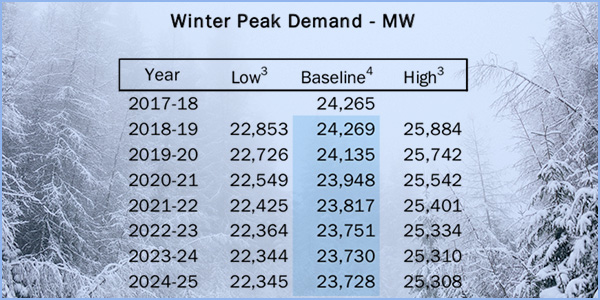By Michael Kuser
NYISO said Tuesday it will have adequate capacity on hand to meet its forecasted peak demand of 24,269 MW for the 2018/19 winter season, well under last winter’s peak of 25,081 MW.
The ISO expects capacity resources, including imports and demand response, to total 43,943 MW this winter, ISO Vice President of Market Operations Emilie Nelson said in a review of the winter outlook.
Installed generation amounts to 41,539 MW, while the ISO has acquired external capacity of 1,519 MW for the winter. Projected demand response resources equal 884 MW, Nelson said.
The ISO forecasts a capacity margin of 11,436 MW based on a 50/50 winter peak forecast with average winter weather conditions consisting of composite statewide temperatures of 15 degrees F. More extreme temperatures in the model (approximately 5 degrees statewide) result in a higher forecasted 90/10 peak load of 25,884 MW, with marginal capacity of 9,821 MW.
“Last winter’s peak [on Jan. 5] occurred during a two-week cold snap, and the all-time winter peak of 25,738 MW occurred in January 2014, during what was called the polar vortex,” Nelson said.
In response to the harsh winter five years ago, “we have fine-tuned many of the things we do in advance of the winter season,” Nelson said. The ISO enhanced its winter reliability planning by providing stronger incentives for generators to secure fuel for winter peak demand needs and improved its monitoring of the natural gas system and checking of generator fuel inventories.
“In preparing for the winter 2018/19, we start by conducting a generator fuel survey … and also we like to understand any arrangements they have in place for replacement fuel,” Nelson said. “This is particularly important in New York, because so many of our generators are located along waterways that allow replenishment of fuel storage through the winter.”
When considering resupply, the focus is on oil, which is typically used as a backup fuel in New York, prompting the ISO to differentiate between resources with fuel tanks that will be drawn down throughout the season and those that can resupply from barges as needed, Nelson said.
In the spirit of testing for extremes, the ISO forecast models a loss of natural gas scenario, which is less about replenishment than demand coming from both homes and power generators, she said.



